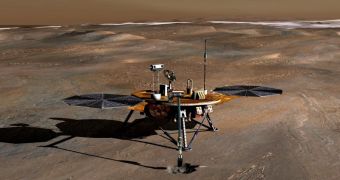More than two months after NASA's Phoenix Mars Lander touched down on the north polar plains of the Red Planet, the pile of circumstantial evidence pointing towards the presence of water was put aside and replaced with the first clear analysis showing that water indeed exists on Mars. In a report published yesterday, the investigation team operating the spacecraft wrote that during a soil analysis carried out earlier this week the TEGA instrument detected the presence of water molecules.
As earlier said, most of the evidence indicating the presence of water on Mars was so far indirect. For example, in 2002 NASA's Odyssey orbiter revealed what appeared to be large reservoirs of water ice, while images sent back by the Phoenix lander showed what looked like white minerals similar to ice that sublimated when exposed to sunlight. The latest analysis however, is the first ever to confirm these presumptions.
"We've now finally touched it and tasted it. From my standpoint, it tastes very fine," said William Boynton of the University of Arizona in the press conference announcing the discovery.
According to the report, the finding came in the outcome of a simple soil analysis. Following the previous failed attempts to deliver soil and ice mixtures to the ovens of the TEGA instrument, the lander was commanded to examine a pure soil sample. Apparently, the sample was not as pure as everyone expected and the ice crystals inside it vaporized and formed water molecules as the oven was heated to 0 degrees Celsius. Future investigations will most likely involve bringing the temperature of the oven way over 0 Celsius, in order to reveal possible carbon based compounds contained in the soil.
Additionally, NASA decided that due to the difficulties experienced by the spacecraft in the last couple of weeks, the three month mission will be extended by another two months, which is expected to draw yet another 2 million US dollars out of the agencies' pockets. Also, the investigation team released a color panorama of the landing site around Phoenix, which consists of more than 400 images taken throughout the mission, revealing an environment coated with dust and rocks.

 14 DAY TRIAL //
14 DAY TRIAL //